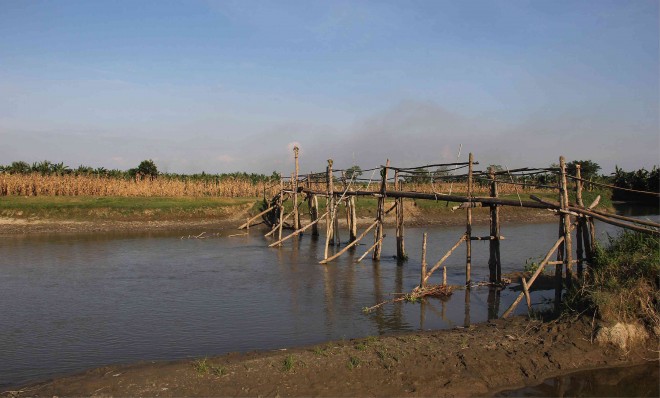Tukanalipao bridge and its symbols

THE BRIDGE in Tukanalipao, Mamasapano town, Maguindanao province, where Special Action Force commandos met their tragic death. BARRY OHAYLAN/CONTRIBUTOR
MAMASAPANO, Maguindanao–Whatcould now be the most photographed wooden bridge in the country continues to play a key role in the village of Tukanalipao in Mamasapano town, Maguindanao province.
It gives access to farmers, children, women and, yes, guerrillas, to other villages and the rest of the town.
On Jan. 25, it gained notoriety as the bridge where many of the 44 Special Action Force (SAF) commandos wiped out in a mission to get international terrorist Zulkifli bin Hir, alias “Marwan,” met their deaths.
Near the bridge landing, the bodies of 35 commandos lay after the SAF’s biggest debacle.
Little known, however, is that it is the same bridge where farmer Badrudin Langalan was allegedly taken, tied and killed by the SAF men.
Center of attention
After Jan. 25, the bridge became sought after—by politicians, government officials and even artists.
While it took bloodshed to place the bridge at the center of national attention, the daily humdrum lives of people relying on it would be testament to what the wooden structure actually represented—dire poverty in a land of plenty.
The bridge was the only access the SAF had to Marwan’s hideout just as it is the only access for the people of Tukanalipao to the rest of the town.
Farmers need the bridge to bring their produce to markets outside Tukanalipao, a village dependent mainly on agriculture but which also hosts a community of Moro Islamic Liberation Front members and their families.
War and peace
To Mujiv Hataman, governor of the Autonomous Region in Muslim Mindanao (ARMM), the bridge has become a symbol of what war is all about and why peace is the only alternative.
“It is almost impossible to foster peace where there is poverty,” he said in a phone interview.
He said he had committed to allot P15 million to build a 20-meter-long concrete bridge to take the place of the wooden one.
“The farmers of Mamasapano now have nothing but a wooden footbridge over which to carry their crops to market,” Hataman said.
The budget for the envisioned concrete bridge, Hataman said, would come from the P250-million savings earned by the Department of Public Works and Highways as result of fighting corruption and kickbacks in the region.
Precarious
The planned bridge, the ARMM governor said, “is a concrete step toward the improvement of agriculture and industry” not only in Tukanalipao but in the entire Mamasapano town.
A concrete bridge, he said, would enliven economy in the area, which is a requisite for peace.
“Soon the people of Mamasapano will no longer need to walk the precarious footbridge to progress,” Hataman said.
“The new bridge will enable them to walk a more sure-footed path to peace,” he added.
The construction of the bridge in Tukanalipao is a step forward, but more poor communities in the region need the same attention not only from the local government but also from the national government.
Ateneo de Davao University president Fr. Joel Tabora, SJ, said on one of his social networking accounts that it was not violence or arms that would end the conflict, most especially with the Bangsamoro Islamic Freedom Fighters, but the “promise of prosperity, education, peace and freedom.”